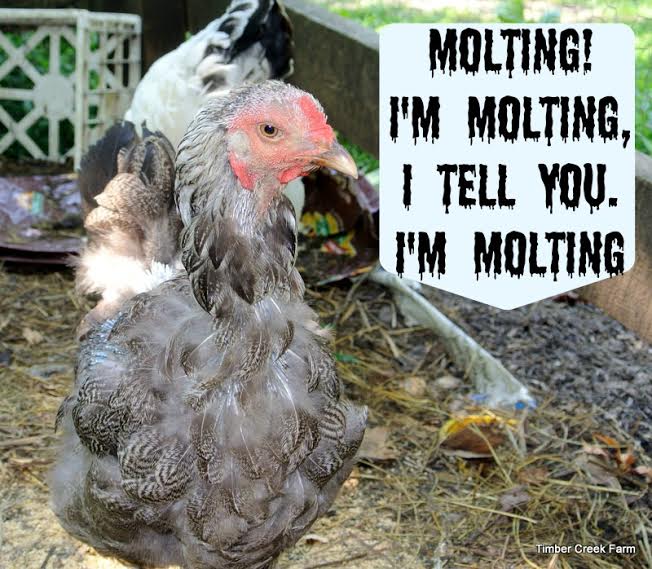It’s late summer or early fall. The days are getting shorter and the heat is finally starting to fade into the pleasant breezes of fall.
One morning, you go out to gather the eggs and notice that it looks like somebody ripped open a down comforter in the chicken coop – feathers are everywhere! Then you take a closer look at your chickens and they’re looking a bit worse for wear.
So what’s going on? Should you panic? Probably not. As long as your chickens are healthy inside and out, they’re probably going through the molting process.
What is Molting?
As you’ve probably noticed from the proliferation of feathers spread throughout your coop and barnyard, molting is when chickens lose their feathers in order to grow new ones.
They do it every year in the late summer or early fall and there’s a pretty obvious pattern that it happens in. They’ll start to lose their feathers around their head and neck, then the back, breast, wings, and finally the tail.
One point that we should touch on now: molting happens naturally at the end of summer but can happen at any time due to physical or emotional stress, dehydration, lack of food, or a sudden change in lighting.
Broody hens will generally molt after their eggs are hatched and they’re returning to normal feeding and exercise habits. If it happens at a time of year other than early fall or your hen hasn’t just hatched her brood, investigate to see what the problem is.
Molting can take anywhere from 4 to 12 weeks, but 7-8 is about average, and the first real molt takes place at around 14-16 months old.
They’ll have two smaller juvenile molts – one at around 4-6 weeks old when they lose their chick fluff and again at around 8-12 weeks old when they get their second set, which is their adult set. It will be obvious, but it’s a little different process that actual annual molting.
What to Expect During Molting
There’s more to the molting process than just losing feathers, and there’s actually more than one type of molting. First you have soft molting, which is when they lose just a few feathers.
Most people wouldn’t even notice. During a hard molting, there will be a fast, massive drop in feathers, leaving you with a sad, deranged-looking, mostly naked chicken.
You’ll also notice a decrease in egg production, which is why many commercial egg factories force all of the chickens into a molt at the same time by starving them for a week or so.
Then they can get back to the business of making eggs in a controlled, orderly fashion. It’s barbaric, and it’s banned in the UK, but it still happens in the US, or it did as of this writing.
How to Help Your Chickens Through Molting
For those of us who love our girls and would never consider such a cruel practice, we just wait them out patiently.
We can, however, help them get back to producing eggs and help them grow better feathers at the same time. And just when you thought you’d made it past that hot summer slump!
Increase Protein
Growing new feathers takes up a tremendous amount of energy and protein, so help them along by meeting that need. Your layers feed is probably 16 percent protein, which is normally perfect, but while they’re molting, switch to broiler feed, which is 20-25 percent protein.
You can give them high-protein treats such as nuts, seeds, soybeans, meat, cod liver oil, boiled eggs, tuna fish, alfalfa, or bone meal. There are several different ways that you can meet their nutritional needs without spending a fortune.
I do want to add that you don’t want to boost their protein too much for too long of a period because it can build up in their systems and cause uric acid to deposit as crystals on joints, which causes gout.
Also, cat food isn’t the best thing in the world to give them because the methionine can cause Heinz-body anemia and death.
Make sure that feeders and waterers remain clean and in good repair, too.
https://www.youtube.com/watch?v=azyPHwntLzo
Video first seen on LittleFarmBigDreams -Elizabeth.
Reduce Stress
Another thing that you can do to help your flock make it through molting as quickly as possible is to eliminate as much stress as possible.
Don’t make a lot of noise that they’re not used to (i.e. don’t choose then to put a new roof on the coop), don’t introduce new chickens to the flock, and don’t move them around during molt.
Turn off the Light
If you use a light in the coop to extend daylight hours, it’s best to leave it off for six weeks or so to let them molt completely. This is for the health of your chickens.
Old, brittle, broken feathers don’t insulate them properly, or help them shed water the way that they should. So, let them molt. Upping the protein will help with the egg production.
Don’t touch them when they have pin feathers
You’ll start to see pin feathers popping through the skin, and those are extremely sensitive and it may be painful for the chicken if you touch them, so avoid doing so if at all possible.
The pins are what will eventually be the quills so they have that tough, shell-like consistency. They’re rich in blood flow when they first pop out and will bleed like crazy even if only one is damaged and cracked a small amount. It’s kind of like a scalp wound for us because the blood supply is rich and close to the surface.
If one is damaged and you can’t get it to quit bleeding, you’ll have to grasp in close to the skin and quickly yank it out, then apply pressure until the bleeding stops. You may need to keep the chicken separate until the wound heals.
Once the pin feather has surfaced and matured, the actual feather will start to spin out from inside of the pin until it’s completely grown, but it’s actually a pretty cool process to watch.
Limit Scratch
By limiting scratch to 10 percent of their diets, you’ll help insure that the additional protein isn’t being diluted.
Protect your Flock One Chicken at a Time
Pay close attention to your chickens during molting time because their bare skin is sensitive and if you have a bully or two in the pen, the molting chicken can be much more easily injured she he or she has no protection.
Keep an eye out for them so they come through healthy and unscathed.
Molting is a natural, healthy part of a chicken’s life cycle and it’s critical to their health. Unfortunately, you may suffer in the form of fewer eggs because of it, but it’s worth it to get the plentiful amounts that a healthy chicken will provide throughout the rest of the year.
Didn’t our ancestors do the same?
Do you have experience or stories about molting, or do you have some funny pictures of your poor chickens in the middle of a molt? If you do, please feel free to share in the comments section below.
This article has been written by Theresa Crouse for Survivopedia.





















































































Hello, Theresa ! Just use the Basics, don’t make it too complicated. Tie a Big Tarp over the chicken House about August 15-20 or so – suddenly cooler residence starts it. Turn out ALL interior night lights – I use several cfls with low wattage. Switch their crumbles (staple diet) to LOW Protein – <10%.. Give them about 3 to 4 weeks – then back to normal.for all. thats it. Moulting is a normal late summer (hopefully) process. Bill
Would you talk about feather loss on hens due to over- attentive roosters?
I am 75 years old and remember when I was a kid and when our chickens would molt my dad would go out and shoot a rabbit
and throw it into pen with chickens to eat on and that was his cure and seemed to work. I guess that supports the protean
fix. I didn’t understand it all then but he had learned that from my Grandparents..
Mary K. – Make your roosters REAL Happy . . . Cut off the points of their “Spurs”, and cut their “Toenails” to a Blunt point. Problem solved. Bill